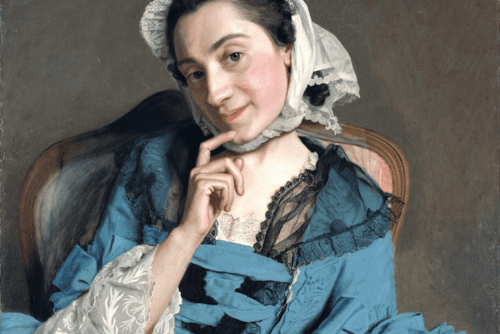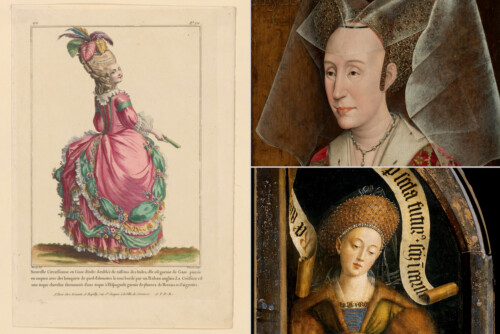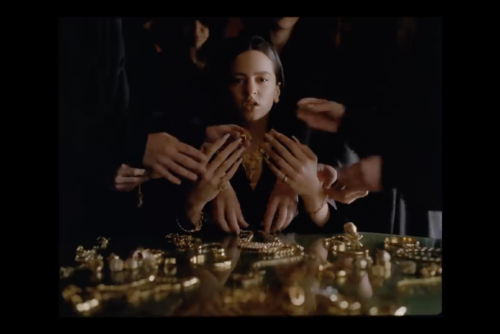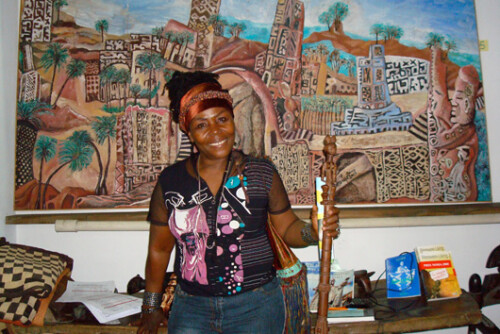“Business Card” and “Celebrity Picture”
Women artists sought the patronage and friendship of women actors, who were, in turn, actively seeking portraitists. Several versions of Romany’s portrait of Thénard as Hermione circulated in the early nineteenth century, of which extant today are a large canvas and a reduction on wood panel (figure 6). The reproduction and dissemination of an image of the actor in a signature role functioned as advertisement and as professional signifier. A role portrait like Romany’s of Thénard was a business card for both actor and painter, featuring their skills and imaginative force.
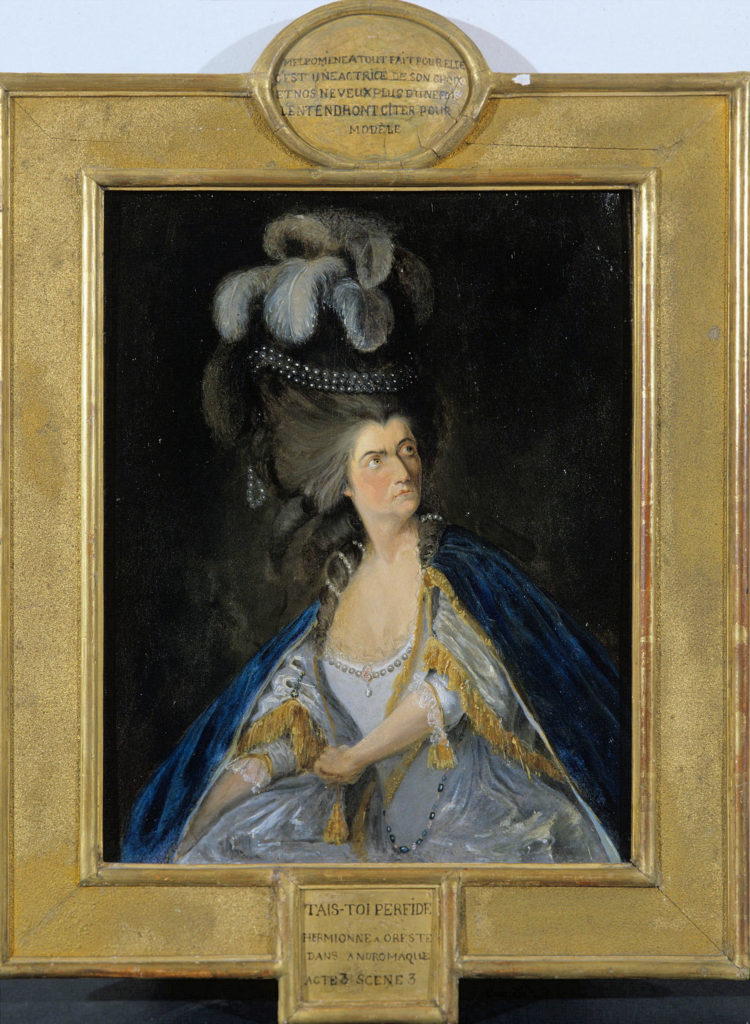
The paradigm of the theatrical portrait as business card has its roots in the mid-eighteenth century, when actors in France and England became public figures like never before under the constant attention of the press, itself fueled by an enthusiastic and growing theater audience. Focusing on the London stage, Shearer West argues that portrait painters sought subjects whose fame would help them to make a name and secure buyers. According to West, “the theatrical portrait was the result, exploiting the fame of the actor and the topicality of his latest performance in an irresistible combination.”1 As such, Romany’s portrait of Thénard appealed to those who had an interest in the actor, the character Hermione, Racine’s Andromaque, or the 1800 staging of the play.
Portraitists typically chose “people celebrated for their talents, power, or beauty” as subjects.2 In her study of French portraiture from the Revolution to the Restoration, Oppenheimer notes a couple of examples of famous women whose portraits disseminated their name and their image, such as Constance-Marie Pipelet, princesse de Salm, known as poet, playwright, and friend of many artists, who was portrayed by Houdon in a sculpted bust, by Girodet in a lithograph, and by Desoria in an oil-on-canvas three-quarter length portrait.3 Unlike other fashionable women who relied on the success of their salons for their public prominence, women actors had direct access to the public through the stage. Norberg compares eighteenth-century women actors to “modern stars” in their efforts to draw attention to themselves and to maintain the interest of the public and of influential individuals.4 Portraits like Romany’s were an effective strategy in that they provided an outlet for the construction and confirmation of women actors’ fame, not unlike glossy prints or high-resolution images of celebrities today.
The word “model,” in English as well as in French, has a double meaning that speaks to the above-mentioned roles of theatrical portraits: a sitter for a portrait, as well as an example to follow. In the case of Romany’s portrait of Thénard, the model is, in the former sense of the word, an actor whose popularity can help the painter’s reputation and demand. In the latter sense of the word, the model is either a positive one, if the viewer chooses to look at Thénard as an accomplished woman, or a negative one, if the viewer chooses to bring Hermione into focus. But the beholder sees both in Romany’s multilayered portrait. This conflation of meaning was cherished and even considered educational for women of high social status. As Oppenheimer explains, women adorned their salons and their bedrooms with portraits of celebrated women of all times.5 Men who admired women actors were a likely pool of potential buyers for portraits such as that of Thénard. However, given the high public profile of Thénard and Romany in social circles of salonnières (women salon hosts) and women artists, it is safe to assume that an equally likely group of potential buyers for the portrait was other women artists in either theater or the visual arts, and women of “sensibility,” who would display the portrait in the salon or in the bedroom for education and emulation.
The Political Dimension of Women’s Sociability
Women artists like Lebrun and women actors like Guimard organized salons and dinner parties in which women in both professional fields participated. Lebrun mentions in her Souvenirs that Guimard invited painters, including women, to her dinner parties.6 As social events that showcased the carefully constructed persona of the hostess,7 salons and dinner parties are further proof of the connections between theater and the visual arts, fostered by women’s sociability.
Some of these events occasioned major changes in public taste, such as the adoption of the Grecian white dress by fashionable women in the aftermath of the Revolution. In her study of attitudes and tableaux vivants (living pictures), Kirsten Holmström notes that Lebrun took credit for having dressed Emma Hamilton in this style for the first time at Hamilton’s performance inspired by a Poussin painting in 1802.8 As Claire Cage and others note, Lebrun ignited the interest in Grecian dress at her famous dîner à la grecque (Grecian dinner) as early as 1788.9 However, David and Talma contested Lebrun’s claim to have initiated the white dress phenomenon; the actor Louise Fusil, in turn, claimed that it was not Talma but a woman by the name of Mme de Saint-Huberty who first turned to Greek models.10 These controversies shed light on the contemporaneous politicization of women’s sociability and its effects on public taste. It should not be forgotten that Lebrun was a royalist and David a republican. According to Carla Hesse, feminist cultural history tends to embrace an “antirepublican perspective” that presents the pre-Revolution era as “an age of greater sexual equality and freedom for women,” in opposition to the Republican worldview, understood as a brotherhood that rejected the “old bonds of flesh between generations, mediated by the womb.”11 Both before and after the Revolution, social networks that encouraged professional collaboration enabled women to assert their identities as artists despite the detrimental politicization of their presence in the public sphere.
During the Revolution and the first decades of the nineteenth century, women’s identity was more fundamentally challenged than ever before. The political and stylistic events of the Revolution complicated gender with issues of nationality and a notion of modernity paradoxically expressed as Neoclassicism. Hayden White argues that the Revolution failed mainly because no distinction was drawn between history and fiction: “Both the political Right and the political Left blamed mythic thinking for the excess and failures of the Revolution.”12 By evoking performance, theatrical portraits formulated an imaginary, idealized past. At the turn of the nineteenth century, the staging of Andromaque at the Comédie Française was timely as it reflected that thinking. As Mary Jo Muratore argues: “The tragedy of Andromaque is said to lie either in the characters’ unbreakable bond with the past or in their inability to take total refuge within it.”13 Through performance and from the perspective of two women artists, Romany’s portrait of Thénard evokes a similarly tense relation with the past. Thénard as Hermione has a destructive relationship to the past, which in part fuels her desire for revenge. Thénard as Thénard freezes the temporal moment of live acting into a two-dimensional image that is fixed indefinitely. Finally, the painting functions as a post-factum attempt to recreate and memorialize the act of performance that brought together multiple personal, professional, and social identities.
- Shearer West, The Image of the Actor: Verbal and Visual Representation in the Age of Garrick and Kemble (New York: St. Martin’s Press, 1991), 28. [↩]
- Oppenheimer, The French Portrait, 11. [↩]
- Ibid. [↩]
- Norberg, “Actress/Courtesans,” 109. [↩]
- Oppenheimer, The French Portrait, 15. [↩]
- Norberg, “Actress/Courtesans,” 110n26. [↩]
- Dena Goodman, “The Enlightenment Salonnière” and “Salonnières and the Rule(s) of Polite Conversation,” in The Republic of Letters: A Cultural History of the French Enlightenment (Ithaca, NY: Cornell University Press, 1994); Benedetta Craveri, Teresa Waugh, trans., The Age of Conversation (New York: New York Review Books, 2005). [↩]
- Kirsten Gram Holmström, Monodrama. Attitudes. Tableaux Vivants: Studies on Some Trends of Theatrical Fashion, 1770–1815 (Stockholm: Almqvist & Wiksell, 1967), 118. [↩]
- Claire Cage, “The Sartorial Self: Neoclassical Fashion and Gender Identity in France, 1797–1804,” Eighteenth Century Studies 42, no. 2 (2009): 202. [↩]
- Cage, “The Sartorial Self,” 202. [↩]
- Carla Hesse, The Other Enlightenment: How French Women Became Modern (Princeton University Press, 2001), 31–2. [↩]
- Hayden White, “The Fictions of Factual Representation,” in Grasping the World: The Idea of the Museum, ed. Donald Preziosi et al. (London: Ashgate, 2004), 24. [↩]
- Mary Jo Muratore, Mimesis and Metatextuality in the French Neo-classical Text: Reflexive Readings of La Fontaine, Molière, Racine, Guilleragues, Madame de La Fayette, Scarron, Cyrano de Bergerac, and Perrault (Geneva: Libraire Droz, 1994), 55. [↩]
